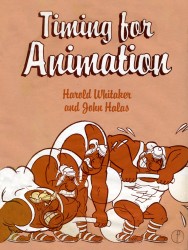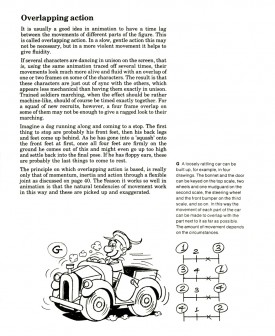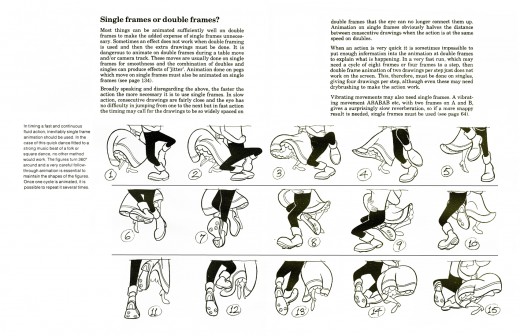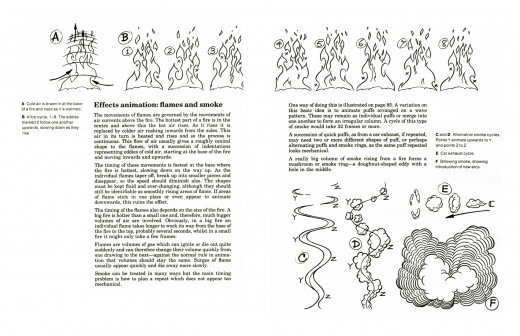Animation Artifacts 15 Dec 2006 08:03 am
Harold Whitaker

 - Harold Whitaker‘s “Timing For Animation.” is an animation book which I like very much, yet it has, I think, gotten short shrift in most animation circles.
- Harold Whitaker‘s “Timing For Animation.” is an animation book which I like very much, yet it has, I think, gotten short shrift in most animation circles.
The book can still be located on line, and I urge you to go for it. It reads like a hard covered Preston Blair primer, yet the information in it is much more detailed than Blair’s and doesn’t attempt lessons in how to draw. The focus stays solidly on how to animate.
The information is clear and concise with illustrations from HB films that Whitaker animated.
(Click on images to enlarge.)
Whitaker was the key animator at the Halas and Batchelor studio. His work has a looseness to it that stands out from most of the animation in the H&B product. He seems to have started animating during the production of Animal Farm and continued working right up through 1988.
Page by page the book offers what seems like a series of valuable lesson plans for would-be animators. There’s so much in the book, but it’s done in a deceptively simple manner, so it seems as if it’s not quite as thorough as it is.
Here, I’d like to post a couple of pages to give a sample of it for you.

The book is called Timing For Animation for a reason. Timing is the essence of animation, and the book focusses on this topic. There are plenty of examples of production charts, exposure sheets and spacing charts.
There are the usual definitions of “Anticipation” and “Follow-thru.” But there’s also examples of “Timing to suggest Weight and Force;” and a breakdown of how to use “Timing Cycles” and the “Timing of a Walk.”
I like the book and have used it for my classes, when I did teach. I also usually recommend the book when I lecture about animation. If you’re not familiar with it, try to check it out.



on 15 Dec 2006 at 3:01 pm 1.Hans Perk said …
I remember meeting Harold Whitaker in Annecy in 1983. He was a VERY shy person, and I saw him only once at a screening, most of the times he was at his hotel – which was the same as mine. I commented about how much I liked his book, and he self-effacingly said that he really didn’t think it was that much of a contribution, and that every night before he went to sleep, he’d read in Frank and Ollie’s Illusion of Life, which he kept on his night stand. I suspect that he was one of many European animators who never had much quality competition, and thus did not get to explore all the possibilities that were in him – as John Halas’ studio was the kind where, if there wasn’t any work, the animators had to sit still with their light tables turned off, not drawing as it wasted pencil and paper…
on 15 Dec 2006 at 4:06 pm 2.Michael said …
Thanks, Hans, for your note. I did very much like Harold Whitaker’s animation and wish he had more attention. You describe the person I guessed him to be, shy and unimposing.
Your comment about the Halas studio sounds just the opposite of Richard Williams’ studio. Dick encouraged you to work on your own projects and even suggested you steal paper. He felt that if you were doing animation on your own, you’d improve by doing it. Ultimately, he would profit from it. (Or so he told me.)
on 16 Dec 2006 at 3:52 am 3.Oscar Grillo said …
I’ve worked at Halas and Batchelor in the seventies and never heard of that stupid practice..I even made my own little films there on my free time and they were shot at the studios expense…I really don’t know what Mr Perk is talking about.
Harold was really shy but pleasant and courteous, a very nice man and a wonderful animator!
on 16 Dec 2006 at 7:36 pm 4.David N said …
Well, at least one other animation director shares your enthusiasm for Harold Whitaker’s fine book: John Lasseter , who wrote the forward for the most recent re-printing of the book.
on 18 Dec 2006 at 5:57 am 5.Oscar Grillo said …
If you see the shorts of “Foo Foo” Harold animated almost singlehandedly for Halas and Batchelor, you’ll see why he was a great animator. Other unsung heroes of the British animation scene of that time are Arthur Humblestone, Peter Sachs and the lamented Tony Whitehouse, who sadly died very young.
on 18 Dec 2006 at 11:10 am 6.Michael said …
Oscar, your comments on Harold’s work as well as your contribution of the names of the other three is enormous, to me. These guys worked years in silence while bosses took some of the credit. They’re the backbone of the British animation business and they’ve gotten so little recognition.
Thank you.
on 10 Jan 2014 at 5:10 pm 7.phil robinson said …
I worked as Harold’s assistant for quite a few years. He was indeed very modest and always shunned the limelight, preferring to work out in Gloucestershire rather than London. He was also a great teacher. Halas and Batchelor ran a school out there for several years that I was lucky to attend. After the training school closed John Halas kept the Stroud studio open just so Harold could stay working in the country.
Harold worked on that book for years. I actually in-betweened on some of the examples in his book. By the way, the exhaust smoke cycle (Example E) has the 2nd and third drawings transposed. Sorry, animation geek stuff.….
Harold was the quiet giant of British animation and should have had far greater recognition.
Phil